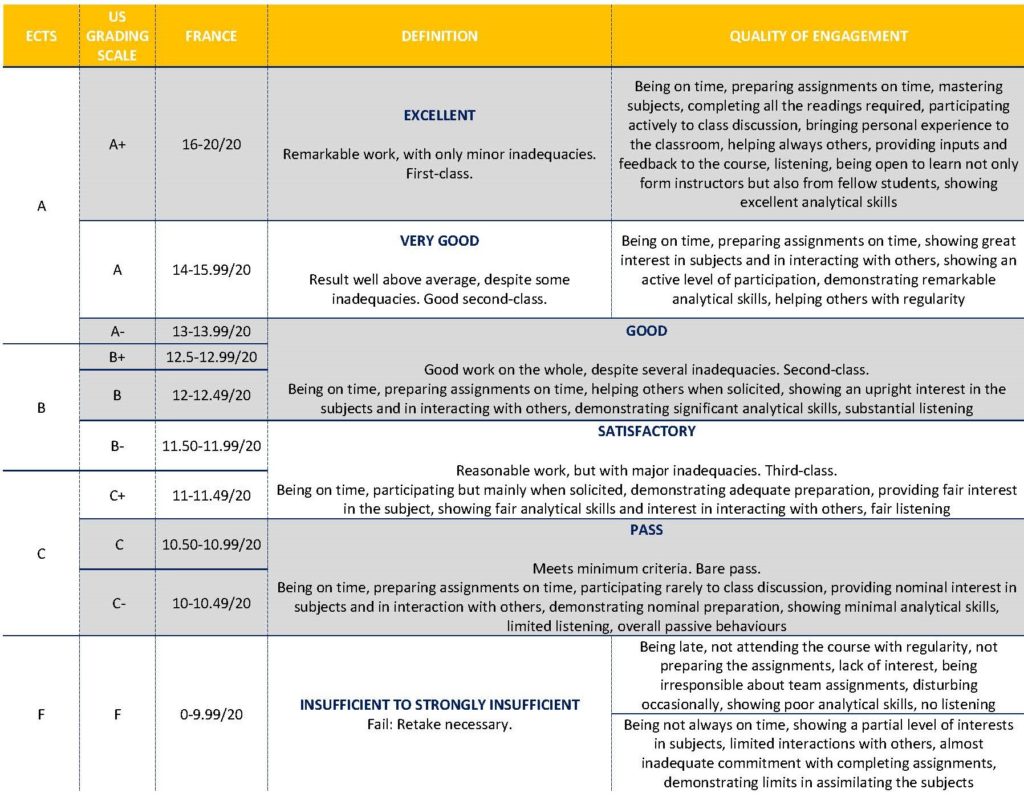You can check the Université Catholique de Lille general online course catalog for course descriptions.
Once on the catalog, choose IÉSEG as School or Faculty and then choose “search” without setting any specificities in your research. Once you have the full list of courses studied at IÉSEG, just hit “Ctrl + F” (quick search) and enter the course title in the little window which just opened. The word / title you are looking for will appear in blue on the page. Click on the course title to get the syllabus, which will outline the following: level, semester, language of instruction, amount of ECTS credits, prerequisites, learning outcomes, course description, class type and assessment.
Pay attention to the “Level” and Program indicated on the syllabus. “Bachelor”, “Master” and “Course for exchange students”, all related to the Grande Ecole Program.
Please note that the campus does not appear on the course syllabus.
GRADING SCALE
Explanation of the ECTS course code
If we take the example of the “CIVIL LAW” course of which ECTS code is:
“1516-IESEG-BA1S1S2-LAWB1-CE01UF”
This ECTS course code is made up of two parts:
1/ 1516-IESEG-BA1S1S2 : Specific code to the Lille Catholic University which means that the course is proposed in 2015-2016, at IESEG, in first year of Bachelor cycle (BA1), on each of both semesters (S1S2)
Other possibilities:
| Study years | Period |
| BA2 (2nd year of Bachelor cycle) | S1 (semester 1 : only from September to December) |
| BA3 (3nd year of Bachelor cycle) | S2 (semester 2 : only from January to May) |
| IN (Courses only available for exchange students) | Y (year : staggered all over the academic year) |
| M (Master) | |
| MIB (Master in International Business) | |
| IMB (International MBA) | |
| MFM (Master in Fashion Management) | |
| MDM (Master in Digital Marketing) | |
| MAC (Master in Accounting) | |
| MFI (Master in Finance) | |
|
MBC (Master in Business Analysis & Consulting) MBK (Master in Investment banking and capital Markets) MBD (Master in Big Data Analytics for business) MNG (Master in Negotiation for Organizations) |
2/ Examples
Example 1 : LAWB1-CE01UF : specific code to IESEG – Grande Ecole Program
Example 2 : LANMFMCE01UE : specific code to IESEG – Post Graduate Programs
- The first 3 letters characterize the field of study to which the course is attached. In the example above LAWindicate the field of study.
Fields of study are:
| Field | Meaning | Field | Meaning |
| ACC | Accounting | LAW | LAW |
| COM | Communication | MIS | Information Systems |
| DEV | Personal Development | MKT | Marketing |
| ECO | Economics | NEG | Negotiation |
| ENT | Innovation & Entrepreneurship | OPS | Operations Management |
| FIN | Finance | PRO | Professional Project |
| IBE | International Business and Strategy | QMS | Quantitative Methods |
| LAN | Language | RES | Research |
| HRM | Human Resources Management | STR | Strategy Management |
| LAN | Language | THE | Thesis / Consulting Project |
Example 1 :
- 4 thand 5th characters of this second part of ECTS code refer to the year in which the course is proposed:
B1, B2 or B3 indicate that this is a Bachelor course in 1st, 2nd or 3rd year, MA: a Master course, AP: course from the Apprenticeship Master, IN: course for exchange students and TR: transverse course such as certain options as a second modern language. - 7th and 8th characters of the ECTS code refer to the type and the format of course. In the case of our example, the law course is a core course (C) given in extensive format (E).
Example 2 :
- 4th, 5th and 6th characters of this second part of ECTS code refer to the year in which the course is proposed:
MIB: courses intended to MIB students,
MFM : courses intended to Fashion Management students , …
PGP : common courses for postgraduate programs - 7th and 8th characters of the ECTS code refer to the type and the format of course. In the case of our example, the law course is a core course (C) given in extensive format (E).
The various possible cases are:
| Type of course (7th character) | Course format (8th character) |
| C (Core course) E (Elective) F (Obligatory track electives in Master) T (Track core courses in Master) O (Optional course) |
E (Extensive : course taught over several weeks) I (Intensive : course taught in concentrated shape over one week, including evaluation) S (Seminar : course taught in concentrated shape generally not exceeding 3 days) |
- The number 01 is a number attributed to the course.
- The next to last letter of the code indicates if it is a module including several courses ( P) or a unique course (U). The courses connected to a module are identified by letters A, B or C.
- The last letter of the code (F) means that the course is taught in French; Emeaning English, A: Arabic, G: German, C: Chinese, I: Italian, P: Portuguese, R: Russian, S: Spanish and X: multilingual.


